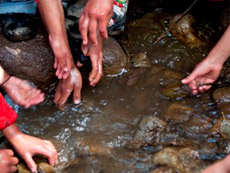The spectacular volcano Tacaná, on the Mexican-Guatemalan border, is the second highest peak in Central America. Several watersheds in the border areas flow to the Pacific supporting small communities. In the high tributary streams, WANI helped develop 12 micro-watershed committees, to manage their shared water and land resources. It also developed links among the committees and with higher-level institutions.
Mexico and Guatemala
The basins of the Suchiate, Coatan, Cahoacan and Cosalapa Rivers cover an area of 3,160km². The Suchiate and Coatan catchments straddle Guatemala and Mexico, while the Cosalapa and Cahoacan Rivers are located entirely within Mexico. Tacana, a municipality in Guatemala, shares its name with the volcano. Land use conflicts are caused by competing water demands during the dry season and flooding in the rainy season. Historically, there was no coordination between Mexico and Guatemala for management of the Suchiate and Coatan rivers. Even within countries, there was a lack of comprehensive policies for catchment management and little or no community organization.
WANI’s Tacana project, which involves all four rivers, convened the first bi-national forum of mayors to identify environmental problems in the Suchiate and Coatan basins. In December 2006, mayors on both sides of the border signed the Tapachula Declaration of Intent to cooperate in joint watershed management. Community pilot projects inspired people to organise themselves into micro-watershed committees. Each project was required to devote at least 40% of its activities to addressing water, soil and environmental conservation. For example, some projects started nurseries for reforestation and others promoted agro-forestry. In Guatemala, a youth-run cooperative enterprise called JEM (Youth on a Mission), which began as an environmental education group of youth volunteers, grew to more than 2,000 members. JEM aimed to create income-generating opportunities for its members. In all, 18 forestry and soil conservation demonstration projects plus 122 management plans for conservation of community forests were created.
In Mexico, these developments coincided with adoption of a new water law that decentralized water management and created opportunities at three levels. First, community pilots and micro-watershed committees were incorporated into municipal development plans in the Coatan basin in Chiapas; second, the Coatan River Committee was formed to coordinate water management among municipalities; and third, a forum for dialogue between the Chiapas Council on Watersheds and the National Water Commission (CONAGUA) resulted in national recognition for Chiapas as a successful implementer of the new water law. The project continued into a second phase funded by the Dutch Embassy in Guatemala. The Tacana approach has been applied in all 14 watersheds in the Suchiate and Coatan River basins. IUCN continues to work on regional transboundary governance and water management issue in WANI-2.
Resources:
Video gallery showing "Grounds for Hope"
Stories: Tacana and JEM of a Business
Unidad de Gestión del Agua from the IUCN website (in Spanish)
